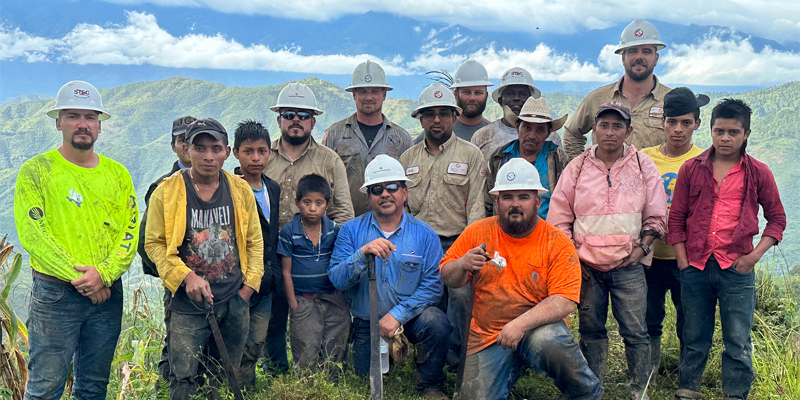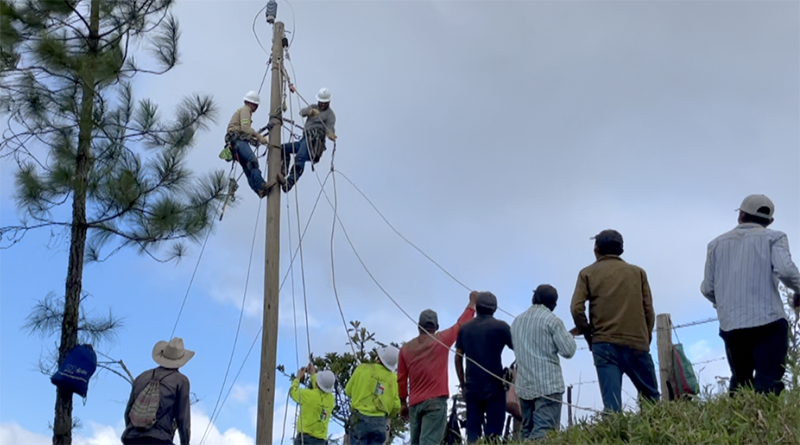South Texas Co-ops Bring Light to Guatemalan Village

Last November, 20 linemen from 10 South Texas electric cooperatives traveled to Guatemala to bring electricity to the rural village of Matasanos in a mission coordinated by NRECA International. CFC and NCSC were proud to provide $70,000 in grants to help finance the project.
Although some Texas electric cooperatives had traveled abroad before to bring electricity to developing countries—including to Bolivia and Haiti—this was the first time that cooperatives from South Texas participated in an overseas project.
“More than anyone else, electric cooperatives understand the value of electrification and the benefits it brings to the community from a quality-of-life and economic benefit perspective,” Varzavand “Avan” Irani, CEO of Nueces Electric Cooperative (NEC), said. He traveled to Guatemala as part of the South Texas team. “In addition to giving the village of Matasanos a helping hand, this project also enabled our line workers to experience the cooperative spirit just like their predecessors did in the 1930s and 1940s,” Irani said. “They got to see, first-hand, the impact of their efforts, and it gave them the opportunity to appreciate the essential services we often take for granted and to bring back those stories to share with fellow team members.”
The trip originally was scheduled to take place in 2021, but was postponed due to the pandemic.
“John Herrera, the now-retired general manager of Magic Valley Electric Cooperative, initiated this project for our group before the pandemic,” Irani said. “When the project was restarted again, planning resumed early in 2023.”
In addition to Irani, four other South Texas electric cooperative general managers joined the team of 20 line workers on this mission: Jim Coleman, Jackson Electric Cooperative; Clif Lange, South Texas Electric Cooperative; Theresa Quiroz, Rio Grande Electric Cooperative; and Blaine Warzecha, Victoria Electric Cooperative.
 Source: Nueces Electric Cooperative.
Source: Nueces Electric Cooperative.
Overcoming Challenges To Leave No Home Behind
Located in a rural area northeast of Guatemala City, Matasanos is a village of 240 people.
Over the course of two weeks, the South Texas linemen constructed 3 km of primary line, 4 km of secondary line and hung five transformers to poles that had been set by the villagers and the local utility prior to the team’s arrival. The line workers connected 47 village homes, a school, two churches and a health clinic. But it was not an easy task.
Just as the team arrived in the country, there was a national strike, bringing most of the project preparation to a grinding halt. The strike caused delays that resulted in the line workers having to work extra hours in order to stay on schedule.
Additionally, the entire project was along a mountainside with very steep terrain. To make matters worse, unseasonal rains made accessing the project sites almost impossible for several days, further delaying the project.
“The linemen faced numerous challenges throughout this project,” Irani said. “The biggest obstacle was the weather. The heavy rainfall made traversing the mountains very difficult—despite having four-wheel-drive vehicles. The linemen put in extra hours and worked through weekends and during their scheduled rest days to ensure the project was complete. They made it their mission to complete all the work before they left, and did not want to leave any home behind.”
The villagers also played a big role in helping move the project along.
“The villagers were a huge help, to the point that, I believe, this project would not have been successful without their aid,” Irani said. “They helped our crews navigate the terrain, orient them on the locations of homes and helped carry a lot of the equipment and materials to the job sites—which was especially important since the terrain was extremely challenging.”
Electricity Improves Lives
Electricity will help improve the lives of everyone in the village.
“A lot of the villagers mentioned how electrification would help with their daily chores such as cooking, and of course adding some much-needed lighting in the area,” Irani said. “One example that stood out was the fact that electricity would reduce the time of the daily chore of grinding grain into flour—which typically takes 4 hours—to 15 to 30 minutes. That allows some of the kids, who often lend a hand doing that, to attend school rather than spend time on chores.”
Electricity will allow the school and health clinic to benefit from the use of modern technology.
“It’s hard to express the heartfelt appreciation the linemen had for the villagers who seemed so content with so little,” Irani said.
“I have given so much over the years to my own community, and love that I had the opportunity to go to Guatemala to do the same,” NEC Lineman and Crew Lead Joe Rivera said.
“It’s about making a larger impact and making a change in these people’s lives,” NEC Journeyman Line Worker John Guzman added.
CFC, NCSC Funds Help Make Project Possible
As is the case with all international electrification projects, fundraising by the participating cooperatives is a big part of planning and preparation.
“We committed to raising $250,000 for this project,” Irani said. “Our generation and transmission cooperative, South Texas Electric Cooperative, and other industry partners supported our fundraising efforts; however, the upfront commitment of $70,000 from CFC and NCSC gave the 10 participating cooperatives a much-needed boost. We are truly appreciative of all the industry support we received, especially for the generous grants from CFC and NCSC.”
When thinking about the overall project, Irani added, “No other project speaks to the essence of the cooperative model like the NRECA International Electrification Program.”
The South Texas cooperatives hope to participate in another international project in 2025.